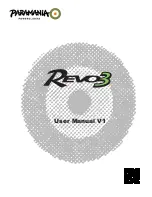
NOTE :
If two lines are pulled, only one A-line is remaining.
Keep hold of the control handles together with the A-lines.
The canopy remains completely controlable through one sided braking or
weight shift. It maintains straight flight but with an increased sink rate (up to
approx. 5 m/sec).
On releasing the A-lines the canopy usually reinflates by itself after a few
turns, or can be aided by a long pump on the brakes and holding them until
tips clear.
B - line - stall :
To induce a B-line-stall pull both B-risers simultaneously by 50 - 60 cm. The
airflow over the top surface is detached and the canopy enters a parachutal-
stall without moving forward.
Further pulling of the B-risers reduces the surface area and increases the sink
rate (to approx. 10 m/sec).
On quickly releasing the B-lines the airflow over the top surface becomes re-
attached and the canopy surges forward to return to normal flight. If canopy
does not recover see section „Deep Stall“.
If B-risers are pulled too quickly or too far, the canopy can form a frontal
horseshoe. To recover from this, apply both brakes gently to recover.
ALL RAPID DESCENT TECHNIQUES SHOULD BE PRACTISED IN SMOOTH AIR
AND WITH SUFFICIENT HEIGHT SO THAT THEY CAN BE EMPLOYED WHEN
NECESSARY IN EXTREME FLYING CONDITIONS ! FULL STALLS AND SPINS ARE
TO BE AVOIDED AS WRONG RECOVERY PROCEDURES, IRRESPECTIVE OF THE
TYPE OF PARAGLIDER, MAY HAVE DANGEROUS CONSEQUENCES !
BY FAR THE BEST TECHNIQUE IS TO FLY CORRECTLY AND SAFELY,
SO YOU NEVER HAVE TO DESCEND RAPIDLY !
Summary of Contents for Axion 22
Page 1: ...PILOT MANUAL Axion ...
Page 21: ...OVERALL PLAN ...
Page 24: ...LINE PLAN ...
Page 25: ......






































